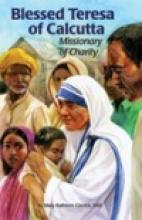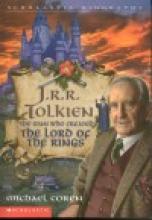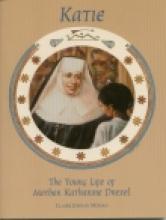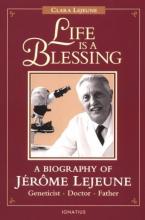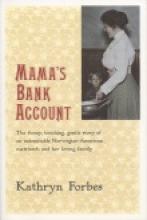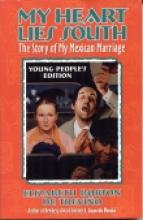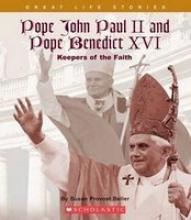20th century Biographies
Blessed Teresa of Calcutta, Missionary of Charity
This book includes all the elements of a good story: an exciting plot, wonderful hero, and well written. Best of all, the story is true. Interwoven throughout the story are quotes from Mother Teresa. There is also a prayer to Mother Teresa and a glossary. (Intermediate reading level - recommended for ages 9-12).
J.R.R. Tolkien
Michael Coren skillfully recounts Tolkien's life - growing up as an orphan, his lasting interest in language and learning and his battle experience in World War I. All the way through he includes interesting and enlightening details - especially ones that we will recognize as relevant to Tolkien's stories. Despite the secular publisher, Tolkien's faith is discussed in some detail (and quite fairly) with Joseph Pearce's book, Tolkien: Man and Myth, (Ignatius Press) featured as a prominent source. Coren does include brief summaries of the Hobbit and the Lord of the Rings which include some real plot-spoilers for those who haven't yet read them (they also aren't the most accurate book summaries I've ever read). I would suggest reading this biography after already having read The Hobbit and the Lord of the Rings. Although intended for youth reading, the story is delightful and interesting for adults (as well as a nice quick read).
Katie: The Young Life of Mother Katherine Drexel
Katherine Mary Drexel (Katie) was born to a wealthy Catholic family of Philadelphia, Pennsylvania, in 1858. As a child she had everything she could wish for - a beautiful playhouse with "carpets, child-size furniture and even a full kitchen." Her parents and her teachers (the sisters from the convent nearby) instilled in her a love for Jesus, and especially the Blessed Sacrament. She struggled with many things familiar to families today - such as trying to understand why she had three sets of grandparents (her own mother died just after Katie was born and her father remarried). The story (which is the style of a first-person narrative - i.e. from the viewpoint of Katie herself) provides warm and personal details about the developing spiritual life of a child which provide an excellent example for young readers in counting their blessings and using their talents for good.
Katie and her two sisters lost their parents when they were still young ladies. Left with a vast fortune, they had to make decisions about suporting charitable organizations. Katie became interested in Missions on American Indian Reservations. Eventually she founded an order of nuns - the Sisters of the Blessed Sacrament. During her lifetime she "opened, staffed, and directly supported nearly sixty schools and missions" and dedicated her life to helping Native and African Americans throughout the United States.
This book includes the story (along with a picture) of two children who prayed to Mother Katherine Drexel for a cure for their little sister. Her miraculous cure was accepted by the Vatican as a true miracle in the investigation process for her canonization. The book also includes many charming black and white photos of Katie and her family, a chronology of her life, and a glossary.
Besides the worthwhile story of a great American saint, the book gives us a glimpse of life in 19th century America. Although many particulars of a Catholic family life are familiar to us today, evidence of the Victorian era are present in instances such as how the nurse explains to the children that their new little sister was brought by angels who visited their mama and papa during the night. The story is charming and gives the reader the feeling that they are really getting to know Mother Drexel very personally. Although I was disappointed with previous writings of Mrs. Mohan (I believe it was because I found the stories too terse, too brief) I thought this story was quite nice and I also appreciate the numerous black and white photos which make for an attractive and appealing book.
Life is a Blessing
Written by his daughter, this book brings us a portrait of a great Christian, loving husband and father, and devoted son who was also one of the greatest scientists of the 20th century.
As a pediatrician, Jérôme Lejeune saw many patients with Down syndrome. Seeking to help these beloved patients and their families, he succeeded in tracing the cause of Down syndrome to an extra 21st chromosome. He could have named the genetic anomaly after himself, but with his characteristic humility, he named the condition "Trisomy-21," meaning three 21st chromosomes (instead of two). While his work did succeed in removing the stigma from Downs (it had previously been thought that maternal syphilis caused it), Lejeune was heartbroken to see his discovery turned into a weapon against the little ones he loved so much.
Further discoveries in the field of genetic medicine followed, including Trisomy-13 and monosomy-9. But despite his pioneering work, which opened up the field of genetically-based diseases, he was never awarded a Nobel Prize, likely due to his unwelcome pro-life views. There was worse to come. Because of his defense of the innocent and defenseless, Lejeune found himself increasingly sidelined. Nevertheless, he continued to bear a hope-filled Christian witness, forgetful of self, a shining example to us all.
Toward the end of his life, Dr. Lejeune worked to found the Pontifical Academy for Life and was (very briefly) its first president. He died on Easter Sunday, a circumstance in which his friend Pope St. John Paul II found a particular significance.
A beautiful book about a great man.
 Originally published in French by Criterion, Paris, 1997.
Originally published in French by Criterion, Paris, 1997.
A newer edition of this title has been published by the Catholic University of America Press in 2022 for the National Catholic Bioethics Center and the Jérôme Lejeune Foundation. This edition's ISBN is 9780935372595. It is only $7.95 direct from the publisher, less than half the current Amazon paperback price.
Mama's Bank Account
When I first proposed to read this story aloud to my children, my oldest, then perhaps 8 or 9 years old, protested loudly! She thought it was going to be a series of numbers and notes about expenditures that I was going to read to her. It only took a little persuading and a few pages before she was hooked. This is a true story - really a set of simple reminiscences - about a Norwegian immigrant family living in San Francisco in the early 1900s (somewhere between the 1906 earthquake and World War I). The stories center around the author's mother, "Mama" - a wonderful character who is difficult to describe with just a few quick adjectives. This is partly because the author reveals her mother's character through favorite family stories in a lovely, subtle way (with plenty of laugh-out-loud spots!). You come to see that Mama is shrewd but completely selfless; she has a wonderful grasp of human nature, but is easily misunderstood (by friends, relatives or readers of the book) because she so readily sees what is good in everyone; she is quiet, but oh, SO stubborn and certainly knows how to get things done in spite of insurmountable odds! Looking through Mama's eyes at the interesting characters that come into her life is a wonderful experience and one you shouldn't miss. Here's a little part of a story to give you a little sense of the book. A boarder, Mr. Hyde, has lived with their family for some time and enthralled all of them by reading classic novels aloud to them every night.
Even when the warm weather came we children didn't beg to go out in the evenings to play one-foot-off-the-gutter. I think Mama was glad; she never liked us running the streets. Best of all, Nels went less and less to the street corner to hang around with the neighborhood boys. The night they got into trouble for breaking into Mr. Dillon's store Nels was home with us. He'd wanted to hear the last chapter of Dombey and Son. Mr. Hyde had taken us deep into Ivanhoe when he got the letter. "I must go," he told Mama. "I shall leave the books for Nels and the children. Here is my check for all I owe you, madam, and my profound thanks for your hospitality." We were sorry to see Mr. Hyde leave, but it was with great excitement that we brought his books out into the kitchen. There were so many of them! We read some of the titles: A Tale of Two Cities, Nicholas Nickleby, Vanity Fair, The Adventures of Alice in Wonderland, Oliver Twist, A Midsummer Night's Dream. Mama dusted them reverently. "So much we can learn," she said. Nels, she added, could read aloud to us each evening, just as Mr. Hyde had done, because Nels too had a fine voice. I could see that made him very proud. Mama showed Mr. Hyde's check to Aunt Jenny. "You see?" she said. "The warm coat I shall have after all." It was too bad that Aunt Jenny was still there when Mr. Kruper came. Mr. Kruper owned the restaurant and bakery down the street and he was angry. "That man Hyde was a crook!" he shouted. "Look at this check he gave me. It's no good! The bank people tell me he cashed them all over the neighborhood." Aunt Jenny's triumphant nod said as plainly as words - I told you so! "I'll bet he owes you folks plenty, too, eh?" Mr. Kruper asked. Mama looked around at all of us. Her eyes rested longest on Nels. "Read," she told him gently, "read to us from Ivanhoe." Then she walked to the stove and put the check into the flames. "No," she answered Mr. Kruper. "No. He owes us nothing."
I think this is best as a solo read for the 12 and up crowd, though it could be read aloud - perhaps with a little explanation or discussion along the way - to children much younger. If you've ever seen the movie I Remember Mama (1948) with Irene Dunne, you're already acquainted with the main characters of this lovely little book. If you haven't seen it yet, you're missing out on a real treasure that could be enjoyed before or after this book. But that's a matter for a separate review.
Copyrights 1943/1971
Mother to the Poor
My Heart Lies South
This story is delightful for its own sake, but also gives tidbits of history (Mexican and Spanish), religion, and culture. It is also the sort of book that is useful and delightful for teenage girls to read as they begin to consider their future roles as mothers, wives and influences on their community. (The humorous incidents will probably keep it interesting enough for the guys as well.) There are some references to dating and courtship, the consequences of drinking too much and other subjects which would not be suitable for young children (although they are handled in a reasonable manner). Don't be turned off by the word "seduction" that shows up in the first few pages. It comes up in a fairly harmless context and is not an indication of shocking material to come.
I also found her discussions of parenting interesting because she was raising her children at a time when American doctors advocated bottle feeding and a sort of detached parenting . When she wrote the story, however, the doctors had begun to come around to a healthier and more natural parenting philosophy and the author expresses some of her regrets and frustrations at following the conventional wisdom which really went against her instincts.
Her arguments in favor of the Mexican view of the role of women is quite compelling. The Mexican role is, in many ways, very Catholic. Women are not inferior or subservient (as in the "Leave it to Beaver" American model of the 1950s) nor do they feel the need to fight for "equality" as in the American feminist model of today. The Mexican women have (or perhaps had) a very strong and dominant role within the family which was the center of society. They liked to make their husbands feel manly by allowing them to help them because it made them better husbands and companions. Although the author does not fully embrace every particular of the Mexican customs in this regard, she sees them generally as the women's way of cunningly "allowing" the men to feel superior in order to keep them happy while almost always having the final word.

